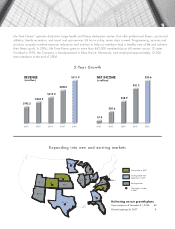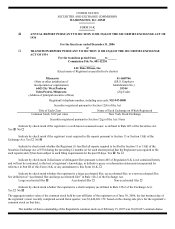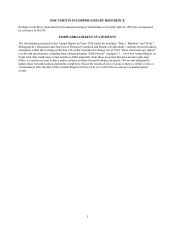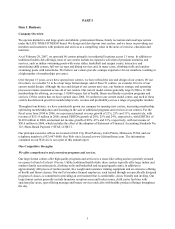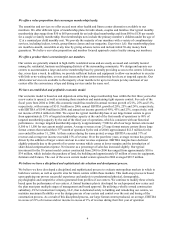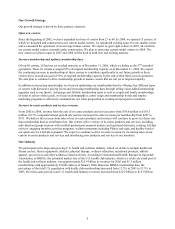Lifetime Fitness 2006 Annual Report Download - page 10
Download and view the complete annual report
Please find page 10 of the 2006 Lifetime Fitness annual report below. You can navigate through the pages in the report by either clicking on the pages listed below, or by using the keyword search tool below to find specific information within the annual report.4
We offer a value proposition that encourages membership loyalty.
The amenities and services we offer exceed most other health and fitness center alternatives available to our
members. We offer different types of membership plans for individuals, couples and families. Our typical monthly
membership dues range from $50 to $60 per month for an individual membership and from $90 to $130 per month
for a couple or family membership. Our memberships now include the primary member’s children under the age of
12 at a nominal per child monthly cost. We provide the majority of our members with a variety of complimentary
services, including lockers, towels, group fitness classes and our magazine, Experience Life. Our membership plans
are month-to-month, cancelable at any time by giving advance notice and include initial 30-day money back
guarantees. We believe our value proposition and member focused approach creates loyalty among our members.
We offer a product that is convenient for our members.
Our centers are generally situated in high-traffic residential areas and are easily accessed and centrally located
among the residential, business and shopping districts of the surrounding community. We design and operate our
centers to accommodate a large and active membership base by generally providing access to the centers 24 hours a
day, seven days a week. In addition, we provide sufficient lockers and equipment to allow our members to exercise
with little or no waiting time, even at peak hours and when center membership levels are at targeted capacity. Our
child center services are available to the majority of our members for up to two hours per day and most of our
centers offer the convenience of spa and dining services under the same roof.
We have an established and profitable economic model.
Our economic model is based on and depends on attracting a large membership base within the first three years after
a new center is opened, as well as retaining those members and maintaining tight expense control. For each of the
fiscal years from 2004 to 2006, this economic model has resulted in annual revenue growth of 21%, 25% and 31%,
respectively, with revenue of $511.9 million in 2006; annual EBITDA growth of 20%, 25% and 24%, respectively,
with EBITDA of $149.0 million in 2006; and annual net income growth of 40%, 43% and 23%, respectively, with
net income of $50.6 million in 2006. We expect the typical membership base at our large format centers to grow
from approximately 35% of targeted membership capacity at the end of the first month of operations to 90% of
targeted membership capacity by the end of the third year of operations, which is consistent with our historical
performance. Average targeted membership capacity is approximately 7,900 for all of our large format centers and
8,500 to 11,500 for our current model centers. Average revenue at our 23 large format mature centers (those large
format centers that reached their 37th month of operation by the end of 2006) approximated $12.5 million for the
year ended December 31, 2006. At these centers during the same period, average EBITDA exceeded 37% of
revenue and average net income exceeded 15% of revenue. Over the past three years, average revenue has grown,
driven by the addition of larger centers and our in-center revenue expansion. EBITDA margins have declined
slightly primarily due to the growth of in-center revenue which comes at lower margins and the introduction of
share-based compensation expense. Net income as a percentage of sales has increased slightly. Our typical
investment for the 30 current model centers constructed from 2000 to 2006 has ranged from approximately $18 to
$34 million, which includes the purchase of land, the building and approximately $3 million of exercise equipment,
furniture and fixtures. The cost of the seven current model centers opened in 2006 averaged $29.5 million.
We believe we have a disciplined and sophisticated site selection and development process.
We believe we have developed a disciplined and sophisticated process to evaluate metropolitan markets in which to
build new centers, as well as specific sites for future centers within those markets. This multi-step process is based
upon applying our proven successful experience and analysis to predetermined physical, demographic,
psychographic and competitive criteria generated from profiles of our centers. We continue to modify these criteria
based upon the performance of our centers. A formal business plan is developed for each proposed new center and
the plan must pass multiple stages of management and board approval. By utilizing a wholly owned construction
subsidiary, FCA Construction Company, LLC, that is dedicated solely to building and remodeling our centers, we
maintain maximum flexibility over the design process of our centers and control over the cost and timing of the
construction process. As a result of this disciplined process, our large format centers produced, on average, EBITDA
in excess of 21% of revenue and net income in excess of 2% of revenue during their first year of operation.


